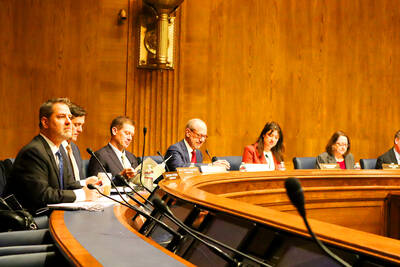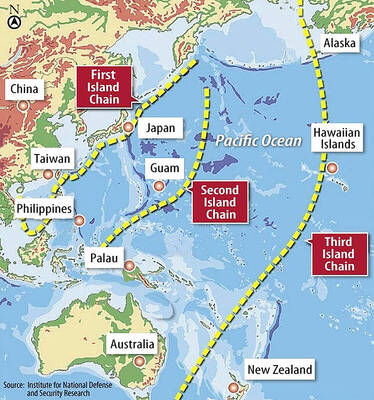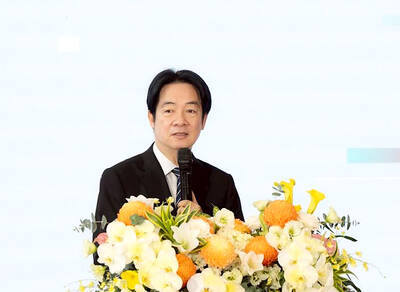Good whisky brands typically take 21 years to mature, and almost the same period of time has been needed for the China market to become ripe for Scotland's most famous contribution to world culture.
Visit any trendy bar or karaoke club in Beijing, and chances are you will see a group of 30-somethings, men and women, gathered around a bottle of Scotch.

PHOTO: EPA
The ever-more hectic nightlife of China's big cities accounts for huge leaps in sales, according to Geoffrey Kau, a manager at Riche Monde (China) Ltd, which distributes the Johnnie Walker brand in the mainland.
"People mix it with green tea, and they can easily finish a bottle within an hour," he said, sitting next to three cases of freshly-imported Black Label.
One-bottle-an-hour karaoke visitors were a main factor helping Riche Monde to double whisky sales in Beijing to 14,000 cases last year, he said.
Chinese markets also helped boost the global sales volume of Chivas Regal by 12 percent last year, according to the owner of the brand, French wine and spirits giant Pernod Ricard.
"Chivas Regal reported increased sales for all regions, with a spectacular acceleration in Chinese Asia," Pernod Ricard said in a statement earlier this month.
Industry-wide, market analyst Datamonitor estimates China sales last year increased at least 20 percent, possibly twice as much, from 294 million yuan (US$35 million) in 2003.
With growth rates like these, the world's whisky producers feel compelled to pay increasing attention to the Chinese market, even though genuine connoisseurship is infrequent even among sophisticated urbanites.
"They don't really know the taste," Kau said. "They just follow the trend and know it's a popular product to drink."
The lack of Chinese interest in the culture and history of whisky is confirmed by tastings of Irish, Scotch and Bourbon organized by Beijing's John Bull Pub.
"Each time, the people who turn up are 95 percent foreigners, and just one or two Chinese," said Frank Siegel, the pub's owner.
The imported drink of choice for China's nouveaux riches remains cognac, but in the long term it may face a disadvantage, as it is not linked to the youthfulness and energy conjured up by whisky, according to analysts.
"Cognac in China is associated with very old men drinking it in oak-paneled rooms," said John Band, a researcher with Datamonitor, who recently completed a study on China's whisky market.
Retailers in the Chinese capital also recognized the youngish profile of people who drink whisky.
"Locals used to stick to vodka, but we see more of them coming to buy whisky," said Lu Wuji, a manager at Jenny Lou's Shop, a popular retail outlet in Beijing. "They are mostly well-off and in their 30s or 40s."
China is likely to eventually become a much bigger market for imported brands than the other Asian giant, India.
This is because most whisky in the subcontinent is indigenously produced, possibly because of influence from the colonial era.
If China's huge potential were to be fully developed one day, the world's whisky reserves would simply be depleted.
"For China to reach the level of Scotch whisky consumption per head seen in Hong Kong and Taiwan, they would need to buy far more Scotch than can conceivably be produced," Datamonitor's Band said.
All the major distillers should be looking at China, even if they may have to wait for a quarter century to see the market boom in a big way, observers said.
"In 25 years, when the people who are currently moving from poor to middle income move to high income, that's when Scotch is really going to take off," Band said.
But perhaps only about five or six companies with a sufficient global infrastructure will be able take full advantage of the Chinese market, he said.
Size and diversity makes it unlike any other country, and many prefer to consider it a continent on a par with, say, Europe.

LIMITS: While China increases military pressure on Taiwan and expands its use of cognitive warfare, it is unwilling to target tech supply chains, the report said US and Taiwan military officials have warned that the Chinese People’s Liberation Army (PLA) could implement a blockade within “a matter of hours” and need only “minimal conversion time” prior to an attack on Taiwan, a report released on Tuesday by the US Senate’s China Economic and Security Review Commission said. “While there is no indication that China is planning an imminent attack, the United States and its allies and partners can no longer assume that a Taiwan contingency is a distant possibility for which they would have ample time to prepare,” it said. The commission made the comments in its annual

DETERMINATION: Beijing’s actions toward Tokyo have drawn international attention, but would likely bolster regional coordination and defense networks, the report said Japanese Prime Minister Sanae Takaichi’s administration is likely to prioritize security reforms and deterrence in the face of recent “hybrid” threats from China, the National Security Bureau (NSB) said. The bureau made the assessment in a written report to the Legislative Yuan ahead of an oral report and questions-and-answers session at the legislature’s Foreign Affairs and National Defense Committee tomorrow. The key points of Japan’s security reforms would be to reinforce security cooperation with the US, including enhancing defense deployment in the first island chain, pushing forward the integrated command and operations of the Japan Self-Defense Forces and US Forces Japan, as

‘TROUBLEMAKER’: Most countries believe that it is China — rather than Taiwan — that is undermining regional peace and stability with its coercive tactics, the president said China should restrain itself and refrain from being a troublemaker that sabotages peace and stability in the Indo-Pacific region, President William Lai (賴清德) said yesterday. Lai made the remarks after China Coast Guard vessels sailed into disputed waters off the Senkaku Islands — known as the Diaoyutai Islands (釣魚台) in Taiwan — following a remark Japanese Prime Minister Sanae Takaichi made regarding Taiwan. Takaichi during a parliamentary session on Nov. 7 said that a “Taiwan contingency” involving a Chinese naval blockade could qualify as a “survival-threatening situation” for Japan, and trigger Tokyo’s deployment of its military for defense. Asked about the escalating tensions

The Ministry of Economic Affairs said it plans to revise the export control list for strategic high-tech products by adding 18 items under three categories — advanced 3D printing equipment, advanced semiconductor equipment and quantum computers — which would require local manufacturers to obtain licenses for their export. The ministry’s announcement yesterday came as the International Trade Administration issued a 60-day preview period for planned revisions to the Export Control List for Dual Use Items and Technology (軍商兩用貨品及技術出口管制清單) and the Common Military List (一般軍用貨品清單), which fall under regulations governing export destinations for strategic high-tech commodities and specific strategic high-tech commodities. The